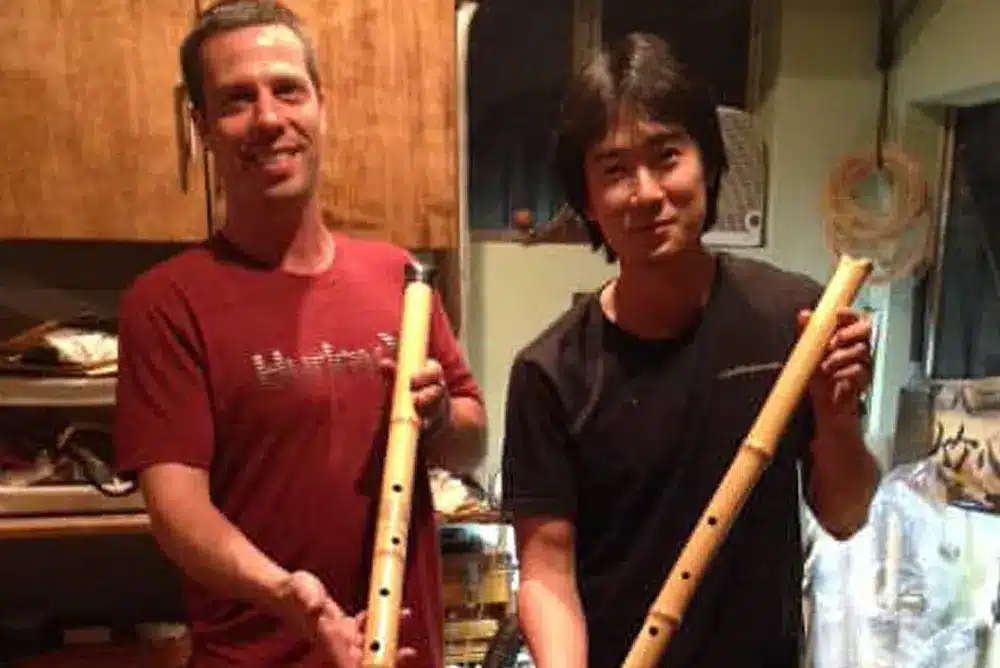
01 Feb The Anatomy of a Japanese Shakuhachi Flute for Beginning Shakuhachi Students
Welcome to Chikushin Shakuhachi, your gateway to the captivating world of Shakuhachi. As you embark on your journey to learn this ancient Japanese instrument, you must grasp the fundamental components of the Shakuhachi and the nuances that set it apart. In this article, we will delve into the Shakuhachi’s technical details, offering a comprehensive understanding of its various parts.
The Jinashi Shakuhachi’s Components:
Let us begin with the Jinashi Shakuhachi, a traditional bamboo flute with a storied history. Its core components include:
Madake Bamboo: The foundation of every Shakuhachi, madake bamboo sourced from Japan ensures the instrument’s exceptional quality and resonance.
Utaguchi: The mouthpiece of the Shakuhachi, where the magic begins. It is meticulously crafted to facilitate the generation of sound and define the instrument’s timbre.
Finger Holes: Precision-drilled holes strategically placed along the body of the Shakuhachi to produce different notes.
Inner Bore: The hollow interior of the Shakuhachi which plays a pivotal role in shaping the sound it produces.
The Jiari Shakuhachi’s Components:
Moving on to the Jiari Shakuhachi, this variation features a unique set of components:
Utaguchi: Similar to the Jinashi Shakuhachi, the Utaguchi on a Jiari Shakuhachi is crucial for sound production. However, it may have distinct characteristics that contribute to its unique tonal qualities.
Ji (Cement): Ji is a mixture applied to the inner bore of the Jiari Shakuhachi, altering its resonance characteristics and tuning.
The Bamboo Used in Shakuhachi Making
At Chikushin Shakuhachi, we hold an unwavering commitment to crafting Shakuhachi instruments of the highest quality, and it all starts with the choice of bamboo. The type of bamboo selected plays a pivotal role in determining the instrument’s sound, resonance, and overall performance.
The bamboo variety of choice for crafting Shakuhachi is known as “madake.” Madake bamboo, scientifically named Phyllostachys bambusoides, is a native species of bamboo found in Japan. It is revered for its exceptional acoustic properties and has been the preferred material for Shakuhachi construction for centuries.
The Mouthpiece (Utaguchi) of a Shakuhachi
The Utaguchi is a critical component of the Shakuhachi, serving as the interface between the player and the instrument’s soulful music. This small but crucial part plays a significant role in shaping the Shakuhachi’s sound, timbre, and playability. At Chikushin Shakuhachi, we understand the importance of crafting this component with precision and care to achieve exceptional musical results.
The Finger Holes and Their Functions
The finger holes on a Shakuhachi are among the most crucial components, enabling the player to produce different notes, melodies, and expressions. These precision-drilled holes are strategically placed along the instrument’s body, each serving a distinct purpose. Understanding the finger holes and their functions is essential for mastering the Shakuhachi.
The finger holes on a Shakuhachi are not just openings in the bamboo but the keys to unlocking the instrument’s expressive potential. Understanding their positions, sizes, and functions is fundamental to becoming a skilled Shakuhachi player. As you embark on your Shakuhachi journey, exploring the intricacies of these finger holes will enable you to communicate your emotions and creativity through the enchanting melodies of this remarkable instrument.
The Inner Bore and Its Impact on Sound
The inner bore of the Shakuhachi is often referred to as the instrument’s “soul.” It is a critical component that significantly influences the Shakuhachi’s sound quality, resonance, and tonal characteristics. Understanding the inner bore and its impact on sound is essential for appreciating the depth and complexity of this remarkable instrument.
As you embark on your Shakuhachi journey, understanding these components and their technical aspects will be invaluable. Whether you are a beginner or a seasoned player, Chikushin Shakuhachi offers lessons and classes with our expert craftsman, Shawnee Schroeder, to help you master this beautiful instrument. Additionally, do not miss the opportunity to participate in our annual workshops with Master Kakizaki-Sensei, where you can deepen your knowledge and skills in the world of Shakuhachi.


